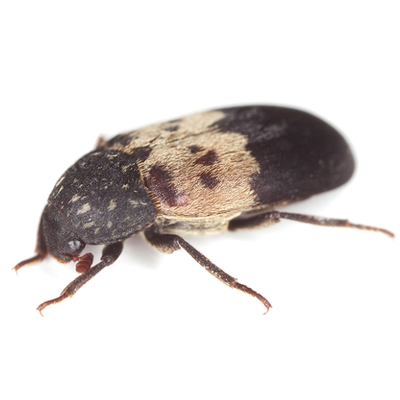
Color: It is usually black with a yellow band across the wing covers. There are several dark spots in the yellow area.
Size: The larder beetle is a large oval insect. The adult is about 7 to 9 mm long.
Adult larder beetles overwinter outdoors as well as indoors in walls.
While larder beetles love our larders, they can also be found in the bark of trees – particularly in the cooler winter months. As mentioned, larder beetles have wings that allow them to fly. They can travel great distances and commonly retreat to trees in winter.
Larder beetles especially like dog food – surprising but true. This means that in addition to the pantry, they can also be found living happily within barns or dog kennels. Bacon and cured meats, hides, feathers, and beeswax are all favorites of the Larder Beetle, though these are rarely kept in pantries. The larvae of the larder beetle will eat bones, wool, fabric that has been stained with blood or sweat, fur, abandoned bird or rodent nests, and stored tobacco – quite a bizarre variety of food sources.
Major injury occurs from larval feeding and the boring of the larvae before pupation. Larder beetles will attack stored ham, bacon, other meats, cheeses, tobacco, dried fish, dried museum specimens, and pet foods, for example. The larvae will bore into any commodity containing meat products; they have also been known to bore into structural timbers. Tests have shown that they can bore into lead with ease and tin with some difficulty. The boring is for the purpose of providing a protected place for pupation, not for feeding.
If a source of larder beetles can be determined than control can be achieved by discarding or cleaning infested woolens, feathers, furs, hides and so forth. However, in the more typical, general infestation the source is probably the dead insects within the inner wall spaces and removal or sanitation is not practical. Cleaning is still recommended. Thoroughly vacuum clean cracks and crevices in the areas where larder beetles are found.
Manufacturer Recommended Products And Treatment For Larder Beetle Control
Pests need food, water, and shelter. Often the problem may be solved just by removing these key items. Before even thinking about chemical pest control, it is important to be aware of
| Conducive Condition | Recommendation | |
| 1 | Tree branches on house | Keep tree branches away from house to reduce pest access |
| 2 | Firewood next to foundation | Keep firewood away from house to reduce pest harborage |
| 3 | Debris on crawlspace/next to foundation | Remove wood debris to reduce termite ha rborage area |
| 4 | Excessive plant cover, stump, etc. | Providing spacing between plant cover and structure |
| 5 | Soil above the foundation Ii ne | Keep soil below top of foundation to reduce harbo rage areas |
| 6 | Wood-to-ground contact | Keep soil from touching wood to eliminate termite access |
| 7 | Debris on roof/full gutter | Keep gutter & roof free of debris to reduce insect harborage |
| 8 | Standi ng water near/under structure | Eli minate standing water to reduce pest harbo rage |
| 9 | Mo isture problem under structure | Increase ventilation to reduce pest harbo rage area |
| 10 | Openi ngs at plumbi ng & electronics | Seal opening to reduce pest access |
| 11 | Excessive gaps at windows/doors | Seal gaps to reduce pest access |
| 12 | Lea ky plumb ing fixtures | Repair to reduce moisture for pests |
| 13 | Keep garbage cans covered | Covered to reduce attraction of insects of vertebrate pests |
| 14 | Mo isture damage wood | Repair rotten or damaged wood to reduce insect harborage |
| 15 | Grocery bags stored improperly | Seal paper sacks in containers to reduce i nsect ha rborage areas |
| 16 | Pet food unsealed or left out | Keep pet food in sealed containers and unavailable to pests |
| 17 | Excessive storage conditions | Keep storage areas uncluttered and manageable |
| 18 | Debris below kick plates | Remove kick plates to reduce rodent harborage |
2 products



